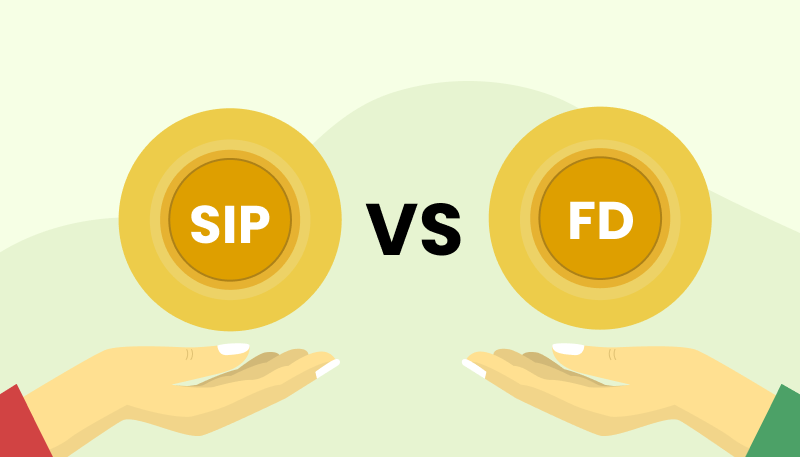When it comes to financial planning in India, two of the most trusted investment options continue to be Systematic Investment Plans (SIPs) and Fixed Deposits (FDs). But in 2025, with fluctuating interest rates, rising inflation, and a growing appetite for market-linked returns, the debate of SIP vs FD India 2025 has become more relevant than ever.
If you’re wondering whether to choose the safety of a fixed deposit or the growth potential of mutual fund SIPs, this guide breaks down the key differences to help you make an informed decision.
What Is SIP?

A Systematic Investment Plan (SIP) is a disciplined investment method where you invest a fixed amount into a mutual fund at regular intervals- usually monthly. It helps investors benefit from rupee cost averaging and compound returns over time.
Key Benefits of SIP:
- Market-linked returns with long-term growth
- Suitable for goal-based investing (education, retirement)
- Flexibility to start with as little as ₹500/month
- Ideal for young investors building long-term wealth
What Is a Fixed Deposit (FD)?
A Fixed Deposit (FD) is a traditional savings product offered by banks and NBFCs. You deposit a lump sum for a fixed period and earn interest, which is predetermined and not affected by market volatility.
Key Benefits of FD:
- Guaranteed returns, low risk
- Flexible tenures from 7 days to 10 years
- Easy to understand and manage
- Option for monthly, quarterly, or annual interest payouts
SIP vs FD India 2025: Feature Comparison

| Feature | SIP (Systematic Investment Plan) | FD (Fixed Deposit) |
| Returns | Market-linked, 10–15% (on average) | Fixed, ~6.5%–7.5% (2025 projections) |
| Risk Level | Moderate to high | Very low |
| Liquidity | High (can redeem anytime) | Medium (premature withdrawal penalty) |
| Taxation | Capital gains tax (after ₹1L exemption) | Taxed as per slab (interest income) |
| Tenure Flexibility | High (any duration possible) | Rigid (fixed term) |
| Best For | Long-term wealth creation | Capital preservation & short-term needs |
This table clearly highlights the pros and cons in the SIP vs FD India 2025 scenario.
Which One Offers Better Returns in 2025?
SIP Returns in 2025:
With the equity market expected to remain bullish in 2025, SIPs in diversified equity mutual funds could yield annual returns between 10–15%, depending on market conditions and fund selection. SIPs also help mitigate the impact of market volatility through rupee-cost averaging.
Fixed Deposit Returns in 2025:
In 2025, major banks are offering FD interest rates between 6.5% and 7.5%, slightly higher than the previous years due to the RBI’s rate adjustments. However, when you factor in taxation and inflation, real returns from FDs may fall below 5%.
So, when it comes to returns comparison in SIP vs FD India 2025, SIPs clearly outperform over the long term.
Taxation: SIP vs FD in 2025
SIP Taxation:
- Equity SIPs: Capital gains up to ₹1 lakh/year are tax-free.
- Above that, gains are taxed at 10% long-term capital gains (LTCG).
- Short-term gains (holding <1 year) are taxed at 15%.
FD Taxation:
- FD interest is taxed as “Income from Other Sources”.
- If annual interest exceeds ₹40,000 (₹50,000 for seniors), TDS of 10% applies.
- The final tax burden depends on your tax slab.
When comparing fixed deposit returns with SIP returns post-tax, SIPs have a clear advantage for investors in higher tax slabs.
When to Choose SIP or FD?
Choose SIP if you:
- Want higher returns over the long term
- Can tolerate short-term market volatility
- Have financial goals like buying a house, retirement, or a child’s education
- Want to beat inflation and grow wealth
Choose FD if you:
- Are risk-averse and prefer capital safety
- Need fixed, predictable income (e.g., retirees)
- Have a short-term savings goal
- Fall into a lower tax bracket
Real-World Example: SIP vs FD in 2025
Let’s assume you invest ₹5,000/month for 5 years:
SIP Investment:
- Total invested = ₹3,00,000
- Expected return @12% CAGR = ₹4,16,000+
- Tax (if gains > ₹1L) = ~₹10,000
FD Investment:
- Lump sum ₹3,00,000 @7% for 5 years
- Maturity Value = ₹4,20,500
- Tax on interest (₹1,20,500) = ₹36,150 (if in 30% tax slab)
Conclusion: SIP gives similar or better returns with more tax efficiency over time, especially for salaried or high-income earners.
Final Verdict: SIP vs FD India 2025
In 2025, the choice between SIP vs FD depends on your risk appetite, investment horizon, and tax slab.
- SIPs are better for wealth creation and beating inflation in the long term.
- FDs are ideal for capital preservation and short-term goals.
If you’re a young investor or planning for future milestones, SIPs will likely deliver better returns. But if you want peace of mind with guaranteed returns, FDs are still a solid choice.
To recap:
- SIP vs FD India 2025 is about growth vs safety.
- Fixed deposit returns are more predictable but often lower after tax and inflation.
- Choose the best savings options based on your financial goals and time horizon.
Pro Tip: Diversify. It’s perfectly okay to have both SIPs and FDs in your portfolio for balanced risk and return.
Let us know in the comments which side you’re on in 2025—SIP or FD?





Great breakdown of SIPs and FDsSIP vs FD comment! One point worth adding is that while SIPs can deliver higher returns in the long run, they require a bit of risk tolerance since markets can be volatile in the short term. Investors should ideally match SIPs with long-term goals and use FDs for short-term needs or emergency funds to balance safety and growth.
This article makes a great point about SIPs offering potential for better returns in the long run. However, I think it’s also crucial to consider your risk tolerance and financial goals before jumping into either option.
Great breakdown of SIPs vs FDs. One point I’d add is that while SIPs tend to outperform in the long run, short-term market volatility can really test an investor’s patience—something FDs protect you from. It often comes down to aligning the choice with your time horizon and risk comfort rather than chasing just the returns.